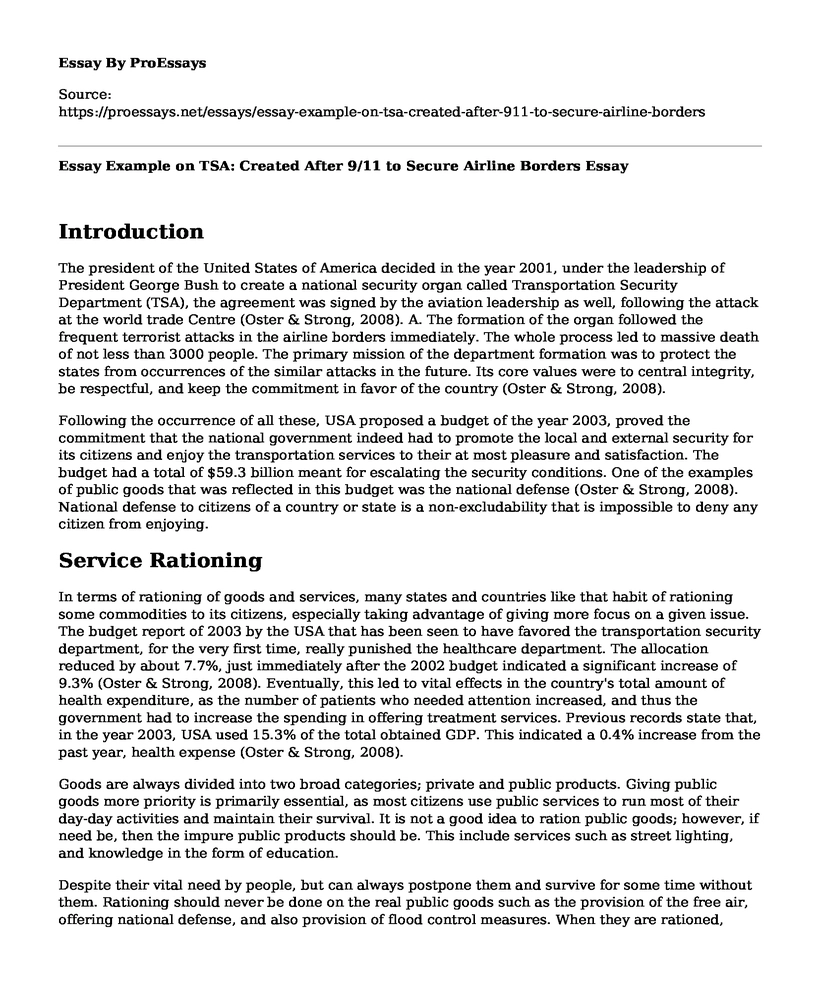Introduction
The president of the United States of America decided in the year 2001, under the leadership of President George Bush to create a national security organ called Transportation Security Department (TSA), the agreement was signed by the aviation leadership as well, following the attack at the world trade Centre (Oster & Strong, 2008). A. The formation of the organ followed the frequent terrorist attacks in the airline borders immediately. The whole process led to massive death of not less than 3000 people. The primary mission of the department formation was to protect the states from occurrences of the similar attacks in the future. Its core values were to central integrity, be respectful, and keep the commitment in favor of the country (Oster & Strong, 2008).
Following the occurrence of all these, USA proposed a budget of the year 2003, proved the commitment that the national government indeed had to promote the local and external security for its citizens and enjoy the transportation services to their at most pleasure and satisfaction. The budget had a total of $59.3 billion meant for escalating the security conditions. One of the examples of public goods that was reflected in this budget was the national defense (Oster & Strong, 2008). National defense to citizens of a country or state is a non-excludability that is impossible to deny any citizen from enjoying.
Service Rationing
In terms of rationing of goods and services, many states and countries like that habit of rationing some commodities to its citizens, especially taking advantage of giving more focus on a given issue. The budget report of 2003 by the USA that has been seen to have favored the transportation security department, for the very first time, really punished the healthcare department. The allocation reduced by about 7.7%, just immediately after the 2002 budget indicated a significant increase of 9.3% (Oster & Strong, 2008). Eventually, this led to vital effects in the country's total amount of health expenditure, as the number of patients who needed attention increased, and thus the government had to increase the spending in offering treatment services. Previous records state that, in the year 2003, USA used 15.3% of the total obtained GDP. This indicated a 0.4% increase from the past year, health expense (Oster & Strong, 2008).
Goods are always divided into two broad categories; private and public products. Giving public goods more priority is primarily essential, as most citizens use public services to run most of their day-day activities and maintain their survival. It is not a good idea to ration public goods; however, if need be, then the impure public products should be. This include services such as street lighting, and knowledge in the form of education.
Despite their vital need by people, but can always postpone them and survive for some time without them. Rationing should never be done on the real public goods such as the provision of the free air, offering national defense, and also provision of flood control measures. When they are rationed, effects such as deaths of citizen and a massive increase in the levels of crime rate in the country can be observed. It is imperative to note that rationing has got a direct impact on the economy spending. In one way or the other, it is the same government that does rationing for some products that suffers later, and in most situation, the expenses that are allocated to eliminate the effects are usually more than the savings that were made in the budget during allocation (Carande-Kulis et al., 2017). However, if it is a must that rationing be done, maybe because of the limited funds to equally fund all the essential projects in a country, then possible options for considerations must begin on looking at the secondary products, because, their absence creates fewer effects on the economy compared to citizens are barred from access to free public goods. USA 2003, the budget was thus fair enough in granting the transportation security department much allocation of funds but was equally unfair in rationing the healthcare department.
References
Carande-Kulis, V. G., Getzen, T. E., & Thacker, S. B. (2007). Public goods and externalities: a research agenda for public health economics. Journal of Public Health Management and Practice, 13(2), 227-232.
Oster, C. V., & Strong, J. S. (2008). A review of Transportation Security Administration funding 2001-2007. Journal of Transportation Security, 1(1), 37-43. Retrieved from https://link.springer.com/article/10.1007/s12198-007-0008-2
Cite this page
Essay Example on TSA: Created After 9/11 to Secure Airline Borders. (2023, Jan 23). Retrieved from https://proessays.net/essays/essay-example-on-tsa-created-after-911-to-secure-airline-borders
If you are the original author of this essay and no longer wish to have it published on the ProEssays website, please click below to request its removal:
- Report Example: Childhood Obesity Among Year 6 Pupils in London Borough of Lewisham
- September 11, 2001 Attacks Essay
- Gender and Identity in the Nickelodeon Television Show - Essay Sample
- Essay Example on Glass Ceiling: Invisible Barrier for Women, Minorities in Trade Hierarchy
- Literary Analysis Essay on The Weight of Shadows
- Essay Example on Sacrifice Zones: The Poorest Places in America
- Police Force & Ethics: Examining the Issues of Police Brutality - Essay Sample







